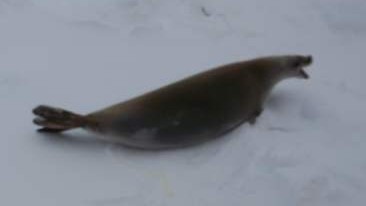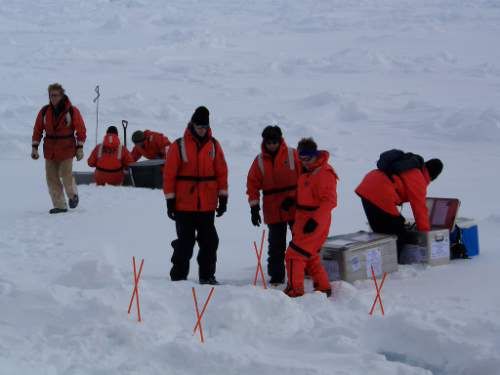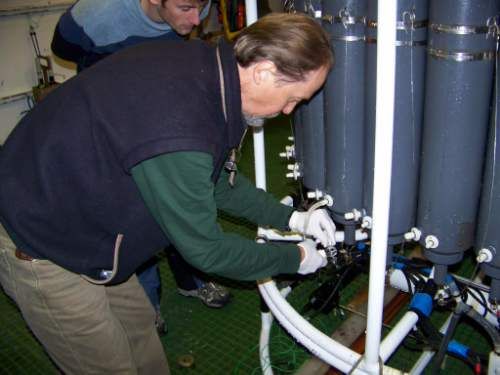**Location: **In the ice, in the Bellingshausen Sea.
Latitude: 70° 16′ S Longitude: 90° 08′ W Air temperature: -2.3° C Water temperature: -1.8° C Relative humidity: 74.7% Barometric pressure: 940.3 mBar ** Antarctic trivia **(answer at the end of this journal entry): How many species of penguin are there?
A good day was had by all! We reached the ice edge around midnight, and wildlife viewing in the morning and early afternoon was unbelievable. Yes, I’m happy to report that I saw my first penguin today! In fact, I saw over a hundred. They are quite social and tend to congregate in large groups. The first group we saw was off the bow on the starboard side of the ship. As they sensed our approach they hurried out of the way, or at least they hurried in the penguin sense of the word. They are powerful swimmers, but on land they don’t move too fast! We watched them slide across the ice on their bellies and waddle around very awkwardly. The ship posed no danger to them, but they wanted to be out of our way. Most of the penguins we saw today were the most abundant penguins, the Adelies. French explorer Dumont d’Urville named these penguins after his wife, Adelie. I wonder what she was like; do you think the penguins reminded him of his wife? I hope not!!
Many more penguin sightings followed, and also many seals. Several hours before and after noon the seals haul out onto the ice and rest – sort of a "seal siesta” – and on the white ice they are pretty easy to spot.
 *
*
This crabeater seal wasn’t too happy about being woken up from his siesta on the ice.
We had a rare sighting of a Ross seal, along with lots of crabeater seals and a leopard seal. A small group of killer whales (a female with two young close by and a male not too far behind) followed us for a while behind the ship in the path we cut through the ice.
**Try this: **A male killer whale can weigh up to 7 tons. How much bigger is a killer whale than you?
We had a planned data collection stop (what we call an ice station) at 2:30 P.M. We are planning to stop 4 times in the next two days to run a pretty complete data collection protocol. We are making these stops on the way to our thirty day home in the pack ice. This is the part of the cruise that has been cut short because of the fire; we had planned to do many more of these "transit” stations on our way in and out of our long stop.

The ice party sets up for data collection. The red poles mark a safe spot to walk across a ridge between two ice floes.
The ice party (the team of scientists working on the ice) was out for three hours. The temperatures were quite comfortable (around -1° C or 30° F) and everyone enjoyed being outside. Beverly, one of the college students in the group, even made a snow angel on the ice…she’s from Canada, but lives in South Texas now, so I think she was pretty happy to see snow!
After the ice party returned to the ship the CTDA research tool that is submerged in the water to measure conductivity (salinity), temperature, and depth. was launched to collect water samples at different depths and record data on the conductivity, temperature, and depth of the water. The scientists will now spend time in the labs aboard the ship analyzing the nature of the collected water. Water samples will also be sent home for further analysis.
 Keith and Gauthier collect samples from the CTDA research tool that is submerged in the water to measure conductivity (salinity), temperature, and depth..
Keith and Gauthier collect samples from the CTDA research tool that is submerged in the water to measure conductivity (salinity), temperature, and depth..
All-in-all, we had a terrific day. Great wildlife and great science…we had a few problems with some equipment that the science support team is working on now. They seem to be able to fix or build just about anything, so I’m sure everything will be in top shape soon.
**Answer to today’s Antarctic trivia question: **How many species of penguin are there?
This is a bit of a trick question! Most people say that there are 17 species of penguin, all living in the southern hemisphere. Some say there are 18 species – it just goes to show that even scientists can’t agree on everything!
Marine mammals and sea birds spotted today by Brent: Cape petrel Giant petrel Snow petrel Crabeater seal Leopard seal Ross seal Killer whale Minke whale


Comments